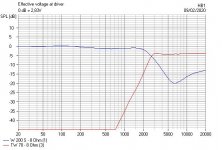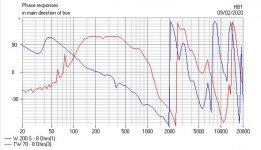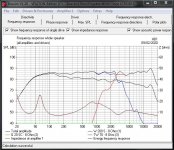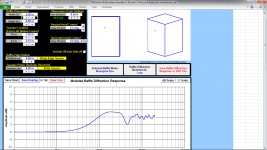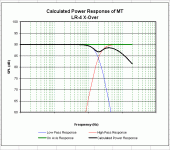Sure, I won't still give up!
Murphy's New Vifa Tower was a wonderful project, very good sounding and with a never listened 3d depth; unfortunately it hasn't that mid-bass 'punchiness' I love such so, to learn designing crossovers too, I tried to migrate to self-made different project.
Murphy's New Vifa Tower was a wonderful project, very good sounding and with a never listened 3d depth; unfortunately it hasn't that mid-bass 'punchiness' I love such so, to learn designing crossovers too, I tried to migrate to self-made different project.
Thiel, when they made some of the most expensive loudspeakers, took pride in touting them as first order designs, and they were anything but simple crossovers - great lengths were taken to the extreme to ensure everything is corrected to exactly first order, a very daunting task. First order crossovers have the same 90 degrees shift as a third order Butterworth. It can't possibly sound inferior because of the 90 degrees. I guess I could make up a justification for this: since the phase difference is uniformly 90 degrees across the audio spectrum, it is just as pleasing to the ear as 0 degrees.
I believe Dennis Murphy has been poorly lately, and had to give up building speakers commercially. But his public designs are still available:
MurphyBlaster Productions
Notice he uses an attenuator on the tweeter. This can help damp the Fs resonance of the tweeter. Lynn Olson also did this in the Ariel.
You'd think the famous old Scanspeak D2905-9500 ferrofluid tweeter is not too shabby. But ferrofluid does dry out. The Vifa M21WO-39-08 is a likeable 8" paper cone designed for reflex.
On the subject of amplifiers, in the 1970's they used huge feedback, but bipolar transistor designs fell apart at the top end due to lack of open-loop gain in old transistors, which meant the feedback couldn't make the rise time any faster than the transistors without feedback. This was called transient intermodulation distortion, and sounded plain fuzzy at the top end, even if you couldn't see anything wrong in frequency response.
Things have doubtless improved now.
Looking at this crossover, I see some issues with coils interacting:
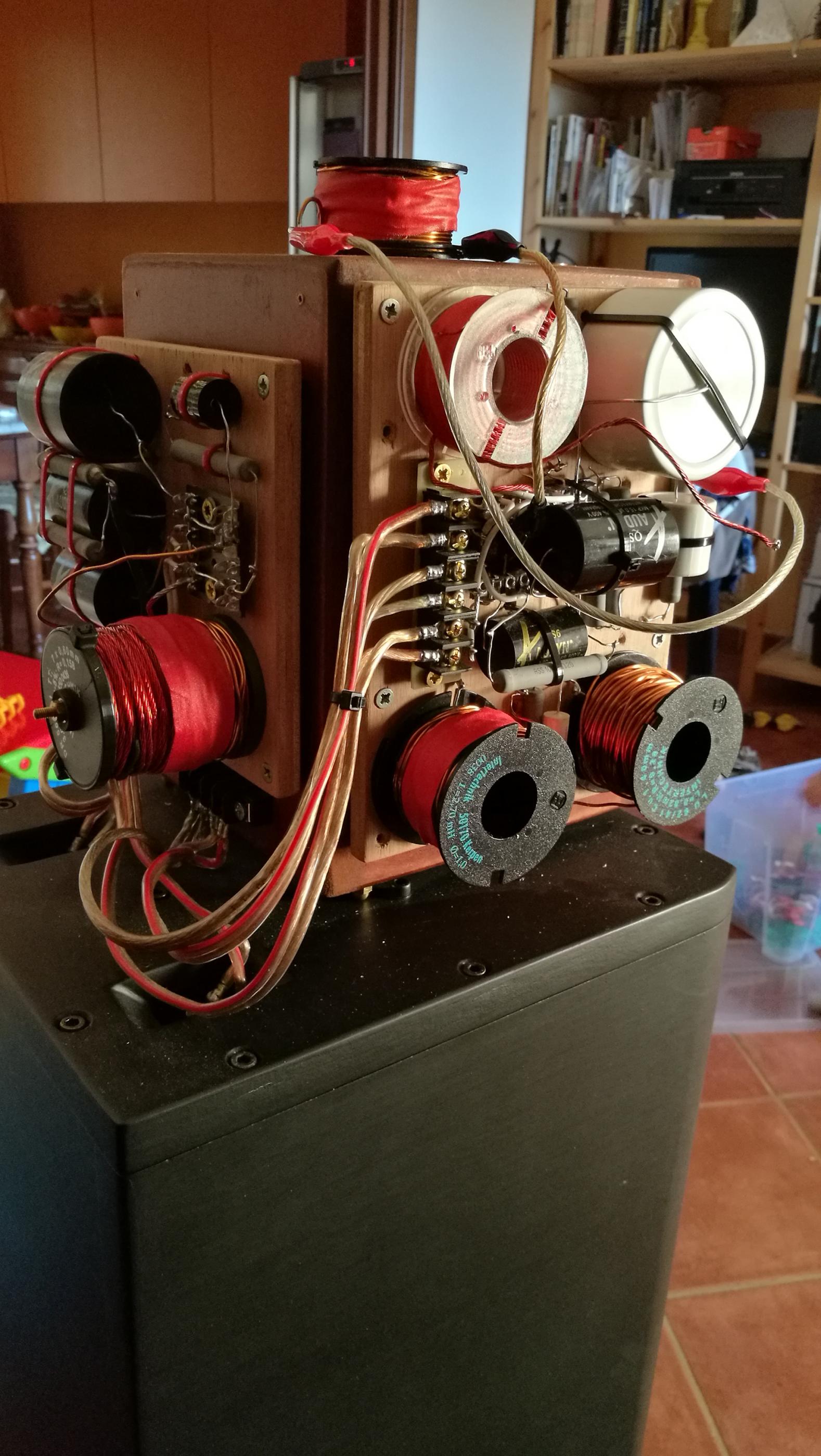
90 degree alignment or big distance between coils is good technique. Yeah, I hate cramming everything in too! 😱
It's an unfortunate fact that 3.5kHz tweeter crossovers make tweeters see high source impedance (lack of amplifier damping) at about 5kHz. Precisely where sibilence occurs. You can model this in boxsim by putting an amp where the tweeter (or bass) was and looking back down the network to the input, which you should short out, to simulate an amps zero output impedance.
Some practical ideas based on something BW3 which I shall be fiddling around with this weekend:
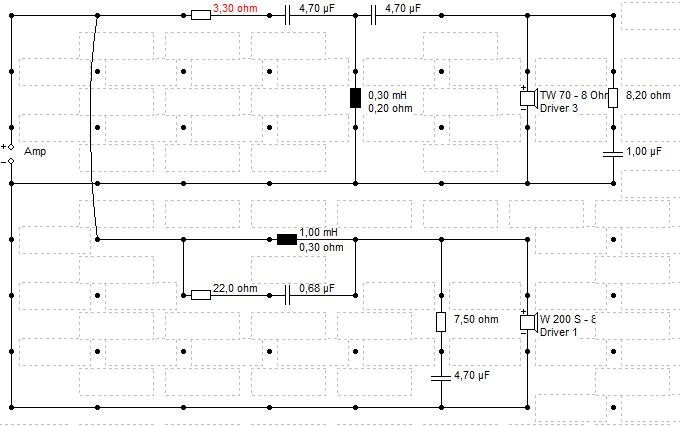
Works in either polarity:
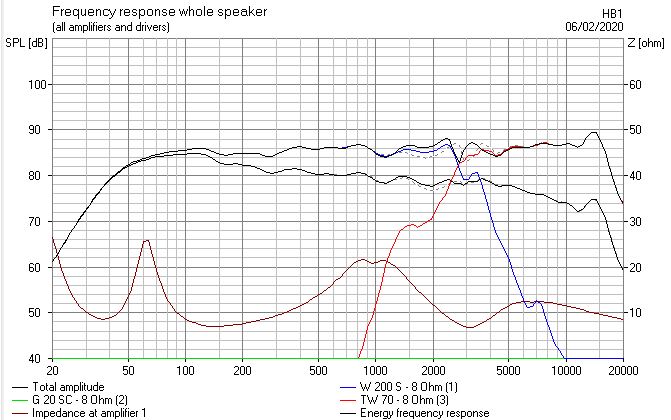
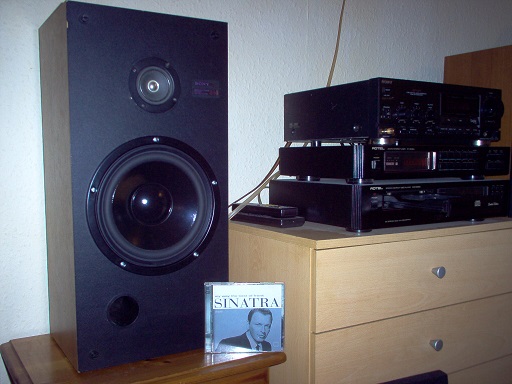
Tank notches on the bass, 22R plus 0.68uF here, at about 5-6kHz take down bass cone breakup, which can intrude. Tweeter Zobels like 8.2R and 1uF can tame the top end and give the amp a more resistive and stable load. Both outpunch their weight in my experience. I tend to go under, rather than over on them.
MurphyBlaster Productions
Notice he uses an attenuator on the tweeter. This can help damp the Fs resonance of the tweeter. Lynn Olson also did this in the Ariel.
You'd think the famous old Scanspeak D2905-9500 ferrofluid tweeter is not too shabby. But ferrofluid does dry out. The Vifa M21WO-39-08 is a likeable 8" paper cone designed for reflex.
On the subject of amplifiers, in the 1970's they used huge feedback, but bipolar transistor designs fell apart at the top end due to lack of open-loop gain in old transistors, which meant the feedback couldn't make the rise time any faster than the transistors without feedback. This was called transient intermodulation distortion, and sounded plain fuzzy at the top end, even if you couldn't see anything wrong in frequency response.
Things have doubtless improved now.
Looking at this crossover, I see some issues with coils interacting:
90 degree alignment or big distance between coils is good technique. Yeah, I hate cramming everything in too! 😱
It's an unfortunate fact that 3.5kHz tweeter crossovers make tweeters see high source impedance (lack of amplifier damping) at about 5kHz. Precisely where sibilence occurs. You can model this in boxsim by putting an amp where the tweeter (or bass) was and looking back down the network to the input, which you should short out, to simulate an amps zero output impedance.
Some practical ideas based on something BW3 which I shall be fiddling around with this weekend:
Works in either polarity:
Tank notches on the bass, 22R plus 0.68uF here, at about 5-6kHz take down bass cone breakup, which can intrude. Tweeter Zobels like 8.2R and 1uF can tame the top end and give the amp a more resistive and stable load. Both outpunch their weight in my experience. I tend to go under, rather than over on them.
It's an unfortunate fact that 3.5kHz tweeter crossovers make tweeters see high source impedance (lack of amplifier damping) at about 5kHz. Precisely where sibilence occurs. You can model this in boxsim by putting an amp where the tweeter (or bass) was and looking back down the network to the input, which you should short out, to simulate an amps zero output impedance.
Thank you Steve, great suggestion, genious I'd say. I've made right some simulation but results aren't comfortable. Here's our reference New Vifa Tower, built and tested as very good system for certain:
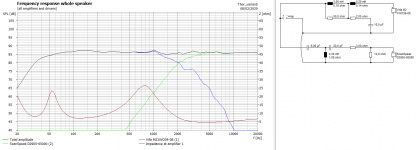
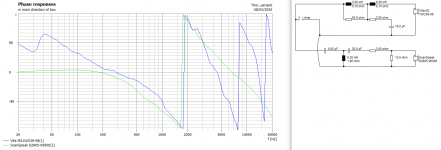
and this is impedance seen by tweeter as you suggested to simulate:
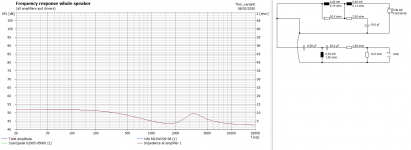
________________________________________________________
Now this is my accursed work (before to try cutting tweeter with a 3rd order, which didn't help and which made me start asking about phase shift):
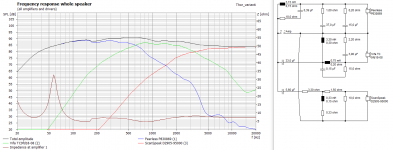

and this is impedance seen by tweeter as you suggested to simulate, overlayed with New Vifa Tower's one:
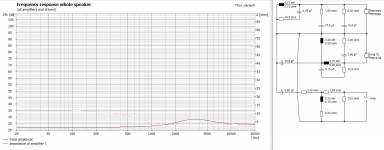
Unfortunately impedance peak seems rather the same..
I haven't any chance but to lower cross frequency using the same stage of New Vifa Tower and modify bass and mid stages.
In parentheses, yesterday I tried using only Vifa TC9 as fullrange, cutting low only with high pass, and I felt that, contrarily to the common sense, its high band output quality is really poor.. a bit of sibilance can be heard already in them uncutted!
Do you know if Marantz PM78 could be one of these..?On the subject of amplifiers, in the 1970's they used huge feedback, but bipolar transistor designs fell apart at the top end due to lack of open-loop gain in old transistors, which meant the feedback couldn't make the rise time any faster than the transistors without feedback. This was called transient intermodulation distortion, and sounded plain fuzzy at the top end, even if you couldn't see anything wrong in frequency response.
It may really be!But ferrofluid does dry out.
I too, believe me, but I have to do my experiment not in a half "space" but in about 1/256 space of my living room..🙁Yeah, I hate cramming everything in too!
I think I can't use D2905 with P830869 in a 2-way because of its earlier breakup, so I'm really frustrated!
Hmm, maybe I should try The New Vifa Tower recipie at some point.
I have modified my M21 woofers with foam surround. It didn't alter the frequency response much per se, but it altered the T/S parametres and sensetivity (and midrange resolution quite a bit).
Foam is of lower compliance than rubber, which means lower mechanical loss. So FS goes up, QMS goes up (better for bass and midrange quality), QTS goes up and VAS goes down.
Boiled down, what I gained at the expense of the lowest bass: Punchier bass, better midrange, higher sensetivity.
I have modified my M21 woofers with foam surround. It didn't alter the frequency response much per se, but it altered the T/S parametres and sensetivity (and midrange resolution quite a bit).
Foam is of lower compliance than rubber, which means lower mechanical loss. So FS goes up, QMS goes up (better for bass and midrange quality), QTS goes up and VAS goes down.
Boiled down, what I gained at the expense of the lowest bass: Punchier bass, better midrange, higher sensetivity.
Thanks for giving me the impetus for some new speaker building, folks! 🙂
The new toys:
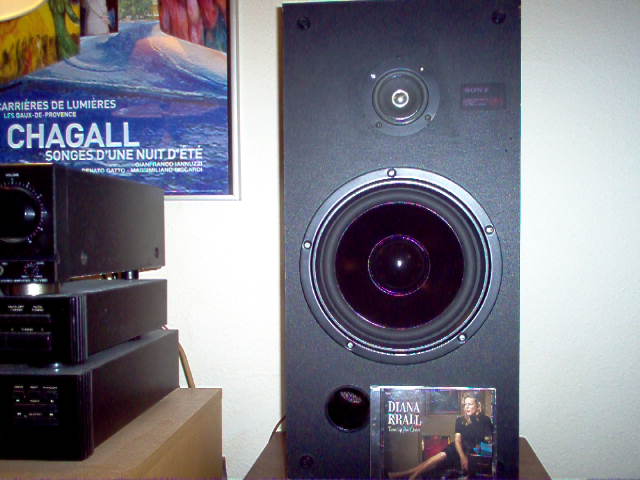
Truly excellent sound. BW3 phase, as you can see. Which makes for no dip in power response and sounds good.
I think this circuit will work with most good 8" midbasses, the Visaton W200S-8 is about 87dB. The notch is about 6kHz and moveable if other woofers are different. Monacor HT22 90dB tweeter.
The woofer sounds very clean if I block out the tweeter with my hand. The tweeter has a bit of fuzz, but nothing objectionable. For £7, who's complaining?
The new toys:
Truly excellent sound. BW3 phase, as you can see. Which makes for no dip in power response and sounds good.
I think this circuit will work with most good 8" midbasses, the Visaton W200S-8 is about 87dB. The notch is about 6kHz and moveable if other woofers are different. Monacor HT22 90dB tweeter.
The woofer sounds very clean if I block out the tweeter with my hand. The tweeter has a bit of fuzz, but nothing objectionable. For £7, who's complaining?
Attachments
Hello, finally took some time to make accurate measurements and discovered many things but the most important is the following.
I tried to cut Scaspeak D2905 lower but with higher order filter , exactly using the same topology of New Vifa Tower that never gave meany problem, and found this impressive response:
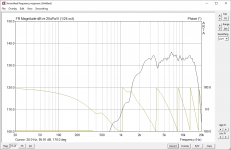
What is that strange behaviour between 2Khz and 6 khz?!
Even unfiltered I had the same thing:
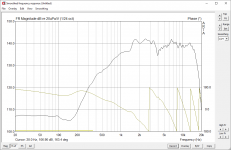
Can this response explain sibilance and other unplesasant sound issues? Have I to deduce that my tweeters are damaged?
For comparison I pulled out from my closet an old SIPE tweeter and took its response, shich seemed very better from the linearity point of view (it's a on the fly measurement, don't take care of cross quality but only of tweeter response, using a simplest 2 components filter..):
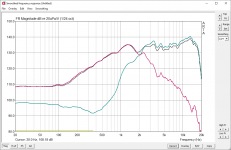
Really sad but at least it seems a real explanation of sibilance, what do you think?
Very interesting thing, infact I always commented the 'dull', not punchy in mid-basses, response of M21 as it is.
If my tweeters were damaged, do you think there's a chance to repair theme?
Thank you.
I tried to cut Scaspeak D2905 lower but with higher order filter , exactly using the same topology of New Vifa Tower that never gave meany problem, and found this impressive response:

What is that strange behaviour between 2Khz and 6 khz?!
Even unfiltered I had the same thing:

Can this response explain sibilance and other unplesasant sound issues? Have I to deduce that my tweeters are damaged?
For comparison I pulled out from my closet an old SIPE tweeter and took its response, shich seemed very better from the linearity point of view (it's a on the fly measurement, don't take care of cross quality but only of tweeter response, using a simplest 2 components filter..):

Really sad but at least it seems a real explanation of sibilance, what do you think?
Hmm, maybe I should try The New Vifa Tower recipie at some point.
I have modified my M21 woofers with foam surround. It didn't alter the frequency response much per se, but it altered the T/S parametres and sensetivity (and midrange resolution quite a bit).
...cut...
Boiled down, what I gained at the expense of the lowest bass: Punchier bass, better midrange, higher sensetivity.
Very interesting thing, infact I always commented the 'dull', not punchy in mid-basses, response of M21 as it is.
If my tweeters were damaged, do you think there's a chance to repair theme?
Thank you.
What is that strange behaviour between 2Khz and 6 khz?!
Can this response explain sibilance and other unplesasant sound issues? Have I to deduce that my tweeters are damaged?
The tweeter is either bad or a poor design and yes, it will cause serious audible problems especially in that frequency range. It looks like a parasitic resonance which is sucking out the response - something loose?
Diffraction possibly? Are your baffle edges rounded/chamfered or square? Did you test old SIPE tweeter on the same baffle as D2905?
Try to measure problem tweeter(s) in near field @ like 10-20cm. Does the dip go away?
TJ
Try to measure problem tweeter(s) in near field @ like 10-20cm. Does the dip go away?
TJ
Diffraction would not likely have that substantial an effect. Diffraction is an audible issue, but seldom does it grossly affect the FR.
That is strange, did you try measuring the tweeter on
very large baffle, perfectly flushed. Some very weird reflection or something internal. Try some 1/4 or 1/2 wavelength calculation for freqs around 4kHz. Yeah, and move the mic starting from say 50cm until 5cm, let's see if it goes away. It might be reflection, it better, rather than internal resonance.
very large baffle, perfectly flushed. Some very weird reflection or something internal. Try some 1/4 or 1/2 wavelength calculation for freqs around 4kHz. Yeah, and move the mic starting from say 50cm until 5cm, let's see if it goes away. It might be reflection, it better, rather than internal resonance.
I remember when trying to minimize glitches when making waveguide face plate for neo dome tweeter, the opening for dome on the faceplate had to be so the domes surround at it's peak would transition to the profile of the waveguide, if not the freq resp had dips.
4k is 8.5cm in wavelength, maybe it is some reflection from something on the baffle.
4k is 8.5cm in wavelength, maybe it is some reflection from something on the baffle.
Just for giggles I made some rough guesses on andreaemme's cabinet dimensions, based on post #17, and plugged it into Jeff Bagby's Diffraction & Boundary Simulator. It's showing about a 2db gain at 1-3kHz range and a 3db loss at around 4kHz. Could be wrong but a quick, close mic'ed measurement will eliminate the question and potentially solve the mystery. 
TJ

TJ
Attachments
Just for giggles I made some rough guesses on andreaemme's cabinet dimensions, based on post #17, and plugged it into Jeff Bagby's Diffraction & Boundary Simulator. It's showing about a 2db gain at 1-3kHz range and a 3db loss at around 4kHz. Could be wrong but a quick, close mic'ed measurement will eliminate the question and potentially solve the mystery.
TJ
Thank you, very useful suggestion by all, today I'll have some difficult to make new measurements but I'll do very soon, using Sipe that now has took place of D2905.
In effects simulator's prediction is very close to my D2905's measurement, but Sipe seems to suffer quite less of this issue. It's a wonderful tweeter, still perfectly working even 28 years old, and it seems more gentle than D2905 for my ears. Highpass circuitry passed from 10 to two components, a simple 4.7 cap and 0.42 coil, as they were wired in their original configuration (Chario Syntar 2). It's a real sin that a brand like Sipe doesn't exist anymore and doesn't produce similar gears.
My original idea was using tweeter baffle-less, what should I have to expect in terms of diffraction and similar issues?
Here's my monster:
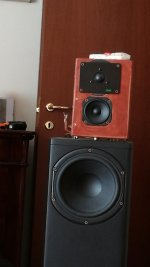
Thank you very much.
To bad some of the Italian spks are not available in North America. There are very good drivers among them. My friend likes Fital Pro a lot.
Indeed a 'monster' it is. Now what if you turn the lower box upside down, move the crossover point in 350-400 Hz. One thing I didn't like is the output from 8" woofer not being attenuated enough above 1kHz - you might want to add some extra 6dB/oct of attenuation to the slope, so the woofers output from it's break up doesn't interact with tweeter. To align the tweeter phase with mid I would try to rise the small enclosure at the front if needed, but I think the vertical distance between them is small and the angle would be too great and cause too much high frequency loss from tweeter operating off axis. Maybe moving the mid forward by having stepped baffle with some felt to lower difraction would be better. Hard to say without trying both options.
I noticed that in LR4 crossover boosting the freq in crossover area (Q somewhat higher than 0.5) helps to counteract the dip in power response and often dip from diffraction or natural dip in tweeter freq resp octave above crossover point makes the loudspeaker sound more natural than having perfectly flat frequency response and rather strange power response - more like LR2 or BW3 (thanks to Roman for posting the graph at his website).
I noticed that in LR4 crossover boosting the freq in crossover area (Q somewhat higher than 0.5) helps to counteract the dip in power response and often dip from diffraction or natural dip in tweeter freq resp octave above crossover point makes the loudspeaker sound more natural than having perfectly flat frequency response and rather strange power response - more like LR2 or BW3 (thanks to Roman for posting the graph at his website).
Attachments
Indeed a 'monster' it is. Now what if you turn the lower box upside down, move the crossover point in 350-400 Hz.
Please be patient, do you mean I may place the bass tower upside-down with woofer near to the floor, far from mid-treble unit? Won't it be excessive the distance beeing tower about 80 cm high?
One thing I didn't like is the output from 8" woofer not being attenuated enough above 1kHz - you might want to add some extra 6dB/oct of attenuation to the slope, so the woofers output from it's break up doesn't interact with tweeter.
I usually fight this issue using a resistor plus a cap in series with main inductor, that helps rather well, however if not certainly it's possible to use an additional order.
To align the tweeter phase with mid I would try to rise the small enclosure at the front if needed, but I think the vertical distance between them is small and the angle would be too great and cause too much high frequency loss from tweeter operating off axis. Maybe moving the mid forward by having stepped baffle with some felt to lower difraction would be better. Hard to say without trying both options.
Indeed my project was born with mid and treble drivers mounted baffle-less on two individual tubes adjustable in depth so I would have been able to align phases; unfortunately (and obviously) midrange didn't work well in a cylindrical tube and I'm still looking for a good conycal shape, at least using 3d plotting, but maybe I'll stop any additional budget for this project, already gone well out..! So I'll be enough pleased with a QB3-like 90 degrees shift with flat on-axis and power response, how said many times in this thread as a good sounding solution.
What do you think about baffle-less solutions? Have you ever worked with? How is their diffraction behaviour?
I remember when trying to minimize glitches when making waveguide face plate for neo dome tweeter, the opening for dome on the faceplate had to be so the domes surround at it's peak would transition to the profile of the waveguide, if not the freq resp had dips.
4k is 8.5cm in wavelength, maybe it is some reflection from something on the baffle.
..opss, I have a terrible idea.. may ever responsibility of my strange issue be the 1 cm high slot between the bass major tower and the mid minor upper tower? In effects minor tower leans upon major through 3 metallic foot 1 cm high so between them there's a discontinuity, introducing to a blank hole formed by two parallel planes of the upper side of bass tower and the bottom side of mid tower.
Could this be the explanation for tweeter issue? If yes, how can I solve it? Will it be enough to eliminate foot and make two towers adherent each other? Or if I will ever be able to find a good shape for mounting baffle-lessly midrange, conycal internally and cylindrical externally, at 1 cm of distance from the upper side of bass tower but eliminating two previous parallel planes, will it work well enough?
Last edited:
The idea of putting the 8in upside down is to minimize floor bounce and to get some lift in bass. I had 3way kit years ago from Mike Dzurko, aka Audio Concepts where the 10" was placed close to the floor crossed around 350Hz to 4.5"mid, slopes around 12dB/oct. - very smooth sounding spkrs. Also my friends towers with passive radiator are similar, forgot the name of the company. The bass driver is active and together with radiator makes so much rumble, no sub is needed.
There was loudspeaker presented in Audio Express some year and half, maybe 2yrs ago, where the tw and mid were placed into egg like enclosure on top of a bass enclosure. Also Canadian designer John..., Waveform loudspeakers made something like this year's ago - Claude Fortier did part of the design (he had Acura Integra type R with 'little' turbo, 450hp+ ,back then - used to come to my friend's garage, my other friend had supercharged type R Civic swap, crazy).
Waveform Research Mach 17 loudspeaker | Stereophile.com
A Bold Speaker Project by Tom Perazella | audioXpress
Waveform: pt1 of 3 | John Gabriel Otvos
Peter Aczel did also review in Audio Critic - I like this man for walking on Earth and being honest, very good read.
There was loudspeaker presented in Audio Express some year and half, maybe 2yrs ago, where the tw and mid were placed into egg like enclosure on top of a bass enclosure. Also Canadian designer John..., Waveform loudspeakers made something like this year's ago - Claude Fortier did part of the design (he had Acura Integra type R with 'little' turbo, 450hp+ ,back then - used to come to my friend's garage, my other friend had supercharged type R Civic swap, crazy).
Waveform Research Mach 17 loudspeaker | Stereophile.com
A Bold Speaker Project by Tom Perazella | audioXpress
Waveform: pt1 of 3 | John Gabriel Otvos
Peter Aczel did also review in Audio Critic - I like this man for walking on Earth and being honest, very good read.
Hello, I've thought to move this discussion on a new thread because it become quite off topic. Here's results of my measurements, interesting and terrific!
Thank you very much.
Thank you very much.
- Home
- Loudspeakers
- Multi-Way
- An explanation about filter topology and phase around cross point
